By Gabor Kunstatter
Physics Department, University of Winnipeg
Based on lectures given as part of the course "Foundations of Physics I", University of Winnipeg, 2002.
1 Black Holes

The picture on the left is a "corral" of iron atoms, arranged in a circle by hand (actually using a scanning tunnelling electron microscope. The corral is around one billionth of a meter across. The circular ripples inside the corral are electron waves, which show that at the microscopic levels, particles such as electrons are not localised. This picture, in addition to being a technological marvel, is striking verification of the bizarre predictions of quantum mechanics, the theory known to accurately describe the world of atoms and electrons. The picture on the right was taken by the Hubble space telescope. It shows the accretion disk of a monstrous back hole at the core of a galaxy many light years away. This picture too is a technological marvel, taken by a telescope in orbit around the Earth, and provides beautiful support for the existence of black holes, which are among the more bizarre predictions of Einstein's theory of gravity, or general relativity as it is known by scientists. General relativiy is known to accurately describe the dynamics of very massive, large gravitating objects. It is an amazing circumstance that the two physical theories graphically represented on this slide are in fact not compatible with each other. If one applies the rules of quantum mechanics to Einstein's theory, one gets puzzling contradictions, an indication that one or both theories must be substantially revised before they can co-exist. The search for a consistent theory of "quantum gravity" unifying the laws of the very small with those of the very large, is currently one of the most important tasks confronting modern physics. The purpose of this talk is to give an overview of Einstein's gravity and black holes, and then to show how black holes are playing such a vital role in this quest for a unified theory of quantum mechanics and gravity. The outline of the talk is given on the next slide.
2 Einstein's Gravity and Black Holes
First I will describe the problems associated with Newton's theory of gravity and then briefly outline the key features of Einstein's theory of general relativity. The remainder of the talk will focus on black holes: their definition, properties, and most importantly how they are observed in nature. Finally I will try to describe why black holes are so important to theoretical physicists, and in what sense they are posing riddles whose resolution will point the way to a viable theory of quantum gravity.2.1 Problems with Newton

Newton's laws of mechanics and universal gravitation worked wonderfully well in describing virtually all terrestial phenomena as well as the motions of the moon and the planets. In this sense Newton provided a beautiful synthesis of two previously distinct sets of phenomena: the terrestrial and the celestial. However, as with all theories and combination of experimental results and conceptual reasoning ultimately forced Newton's gravitation theory to be modified and replaced by Einsein's theory of general relativity. There were essentially three problems with Newton's theory. First of all, there was a conceptual problem. In Newtonian gravity, the strength of the gravitational force bewteen two bodies was proportional to the product of the inertial masses of the bodies. Inertial mass was therefore doing double duty: by definition, it was a measure of the resistence of an object to a change in velocity. In addition, inertial mass seem to also play a role as the "gravitational charge". In much the same way that electric charge determines the strength of electrostatic forces between two charged objects, the inertial mass (a.k.a. the gravitational charge) determines the strength of the corresponding gravitational force. This is the reason that, as found by Galileo, all objects fall to Earth at precisely the same rate. The reason for this double duty is a complete mystery in the context of Newtonian mechanics, but is essentially a trivial consequence of Einsteinian gravity. The second problem with Newton's theory was that it described gravity as an instantaneous force of attraction between two massive objects. Consequently, if you move one of them, the other knows about the move immediately due to the change in gravitation, irrespective of the distance between them. FInally, and most importantly, there was a discrepancy, albeit very tiny, between the predictions of Newton's theory, and experimental observation for the precession of Mercury's orbit.
3 What is Gravity?
As stated above, Newton explained why objects fall towards the earth by postulating an instantaneous force of attraction between all objects. This works really well to a point, but it leaves at least unexplained one startling fact: all objects fall towards the earth at the same rate. This is a complete mystery in Newton's gravity theory. In order to explain this simple fact, Einstein had to completely overturn the Newtonian view of the Universe. In particular, Einstein taught us that that gravity (as an instantaneous force of attraction between two objects) is a myth. Morever, space is not merely an inert stage on which physical phenomena occur. Space is a dynamical entity: it has a shape and structure that is determined by the matter it contains. Objects fall towards the earth at the same rate because they are all trying to follow the (same) straightest possible trajectory in the curved space surrounding the Earth. (Actually, I should be talking not just about space, but space and time together, but it is easier to visualize the geometry of space, rather than spacetime .) A simple sheet, or membrane, like a stretched piece of spandex, can provide a very accurate two dimensional representation of how gravity works, as shown on the next transparency.3.1 Gravity: Space as a Rubber Sheet
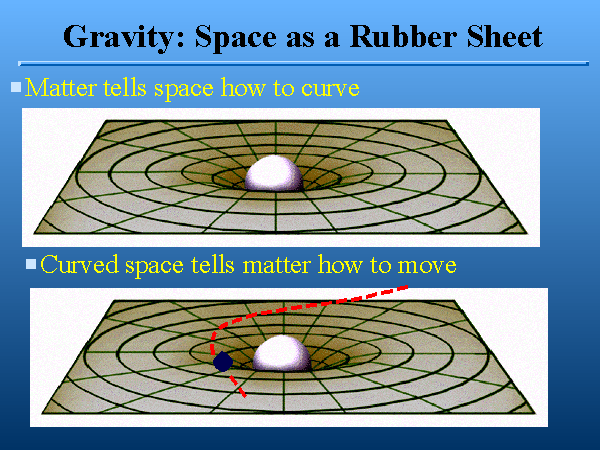
Think of space as a stretched rubber
sheet. When something heavy is placed on the sheet, it causes it to
dip. The heavier the object, the deeper the resulting gravitational
well. In the words of John Wheeler "matter tells space how to curve".
Once one accepts the curvature of space, it is rather easy to see that
smaller objects will move along the straightest possible line that they
can in that curved space. However, this straightest possible line has
different properties than in flat space. In fact, the line itself looks
curved, as shown above. Again in the words of Wheeler, the curved space
tells the matter how to move. In curved space the rules of Euclidean
geometry are no longer valid. For example, it is possible for parallel,
straight lines to meet: think of the lines of longitude on a the curved
surface of a spherical globe: they are parallel at the equator,
straight and meet at the poles. Also, the sum of angles in a triangle
does not have to equal 180 degrees: think of the triangle made by two
lines of longitude that meet at the north pole, and the segment of the
equator joining them. This triangle has two right angles at its base
(the equator), and a non-zero angle at the apex (the north pole). Hence
the sum is greater than 180. Once space itself is curved, everything
moving in it is affected. Thus not only particles, but light too must
feel the effects of gravity.
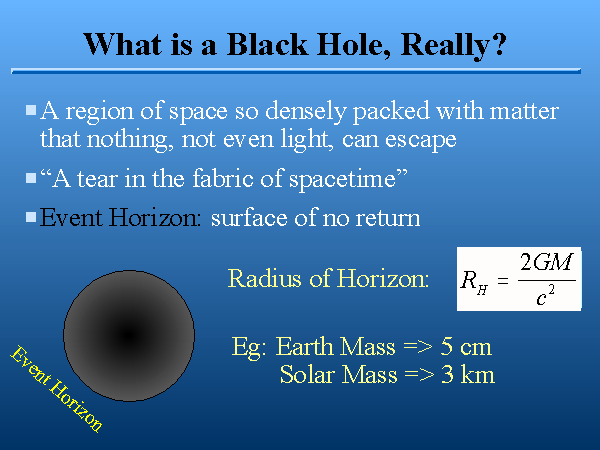
3.2 What is a Black Hole (BH), Really?

In the context of the membrane
paradigm in the earlier slide, clearly the more matter that is put in
the center of the sheet, the deeper the well that is created, and
consequently the harder it is for matter to "climb out" . According to
Einstein's theory, if enough matter is packed into a small enough
volume, the well will get so deep that the matter inside can never
escape. A circle of no return forms. Any matter that passes the point
of no return can no longer escape to the outside world. It necessarily
keeps collapsing, moving towards the center. The well gets deeper and
deeper until finally a hole is literally torn in the fabric of
spacetime: the density of matter at the center becomes essentially
inifinite, at least to the extent that Einstein's theory of gravity is
still valid. Thus, what I mean by " a hole in the fabric of spacetime"
is: a tiny region of space where the known laws of physics break down.
A black hole is then a region of space so tightly packed with matter,
that nothing, not even light can escape. Hidden at its (crunchy?)
center is a tear in the fabric of spacetime. Anything that falls into
this region of space is irrevocably lost to the rest of the universe.
No light can emerge or pass through this region, so it appears totally
black. In some sense therefore, a black hole marks a boundary to
spacetime: a horizon beyond which no one can see without travelling
through it. This radius of no return is called the event horizon of the
black hole.
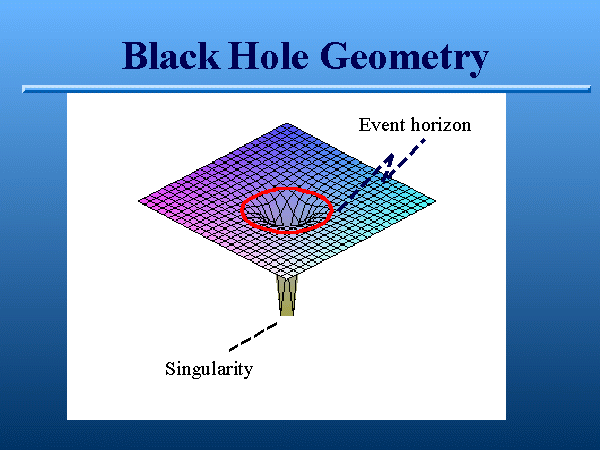
Anything that can be cut can also be sewn. It is mathematically
possible to take two black hole geometries, and sew them together along
their "tears". This gives rise to wormhole solutions to Einstein's
equations, in which two otherwise separate "universes" are connected by
a throat, or tunnel, as shown in the top figure above. Such wormholes
could also connect different regions of the same universe, as in the
bottom picture. In principle this would enable us to take shortcuts to
distant parts of the Universe just like they do in Star Trek. The
problem is that within Einstein's theory such wormholes are very
unstable. The throats tend to collapse in a much shorter time than it
would take to get through to the other side, so that traversing such
wormholes is in practice impossible.
3.3 BH Geometry

This is a two dimensional
representation of what the space containing a black hole would like
like. Far from the black hole, the space is curved, just like around
our Earth, or an ordinary star. Somewhere in the space there is a
circle (actually sphere) which marks the point of no return. Anyone who
travels inside that circle can never emerge, and is doomed to travel
inevitably towards the "tear" in the center.
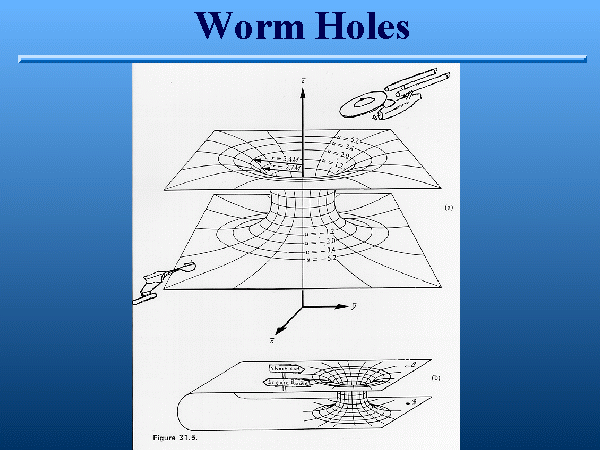
3.4 Worm Holes

3.5 Properties of BH
The space far from a black hole is
kind of boring. It has no distinguishing features besides the degree to
which it is bent, and this bending, is no different than that of an
ordinary star of the same mass. In fact there is a "no hair" theorem
that guarantees black holes to be virtually featureless when viewed
from far away. All the bumps and wriggles of the matter from which they
were formed are smoothed out as the matter contracts, so that the final
shape of the horizon is always perfectly smooth and round. Near the
event horizon, things are more interesting. To a distant observer,
events near the horizon appear to slow down. If you drop a clock into a
black hole it appears to tick more and more slowly as it approaches the
event horizon. Time actually appears to stop right at the horizon. The
clock's motion towards the black hole also slows down and to a distant
observer it takes literally forever to fall through. If you are
unfortunate enough to be falling with the clock, time appears to
progress normally. You fall through the horizon in a relatively short
time, and once you are past it, you get sucked to the singularity at
the center in a millionth of a second (for a solar mass black hole).
Time and space interchange roles, and you can no more avoid falling to
the center than you can avoid moving from the present into the future.
The only 100% reliable way to detect the presence of a black hole is to
fall through the horizon and verify that it is literally impossible to
stop moving towards the center. Of course your discovery won't do your
career much good: there would be no way to publish your results.
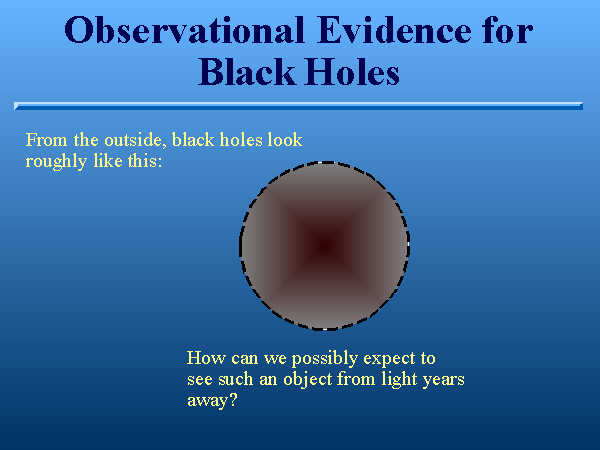
According to what I have been saying, from the outside black holes are simply that: black holes in space. They would therefore be very difficult to spot from very far away.
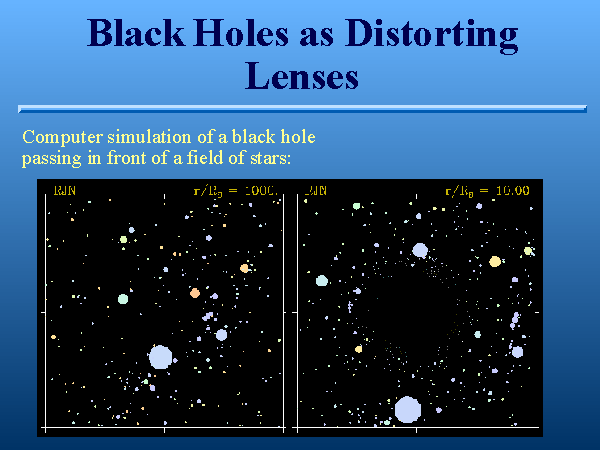
3.6 How do BH Form?
It is unlikely that we will be able to manufacture black holes in the laboratory. The density of matter required is too great. In order to make a black hole the size of a baseball, you would have to pack all the matter in and on the Earth into a volume the size of my fist. This is much greater than the density of nuclear matter, for example. There have however been suggestions recently that certain types of microscopic black holes can be made by smashing heavy ions together in particle accelerators. Such suggestions depend critically on some as yet speculative assumptions about the nature of gravity at the microscopic level. It will be interesting to see whether these conjectures can be realized. Nature, on the other hand, seems to have not difficulty making black holes. Gravity is always attractive. Matter naturally collapses unless there is some other force to hold it up. The objects in this room are kept from collapsing by electromagnetic forces. The gas in an active star is held up by thermal pressure. However, once a star uses up its thermonuclear fuel, it starts to collapse, and if there is enough mass to overcome other, microscopic forces, it invariably collapses into a black hole. Stars in galaxies also collapse, and there is considerable evidence for the existence of black holes at the center of most galaxies, including our own.4 Observational Evidence for Black Holes

According to what I have been saying, from the outside black holes are simply that: black holes in space. They would therefore be very difficult to spot from very far away.
4.1 Black Holes as Distorting Lenses

One possible way to spot them in
principle is to use the fact that they act as powerful lenses. Any
light passing near the black hole gets bent and any stars that we see
behind the black hole get distorted. This is a computer generated image
of the effect a black hole would have if it passed in front of a field
of stars. Unfortunately, this is only useful if the black hole is
moving relative to the distant star field, so that we can detect the
change. The black hole has to be passing by fairly close to the Earth,
and we have to be looking at the right place at the right time.

4.2 BH Detection via Microlensing

The gravitational lensing effect can
be used to spot black holes in another way. If a black hole passes
between us and a single distant star, the black hole would focus the
light from the star into our telescope and, instead of causing it to
blink out by passing in front of it, it would instead cause the star to
appear temporarily brighter. Thus another way of looking for black
holes is to observe distant stars, perhaps by computer, and look for
this characteristic temporary brightening. This slide shows a candidate
event of such a "micro-lensing effect". The star in the box in the
lower left picture appears brighter in November, 1996 than it did in
April, 1996 because there is an invisible, dark very heavy object
directly between the star and us, focussing the light into our
telescope. Unfortunatly, this particular event seems to be due to a
compact burnt out star, rather than a black hole, but the search
continues...
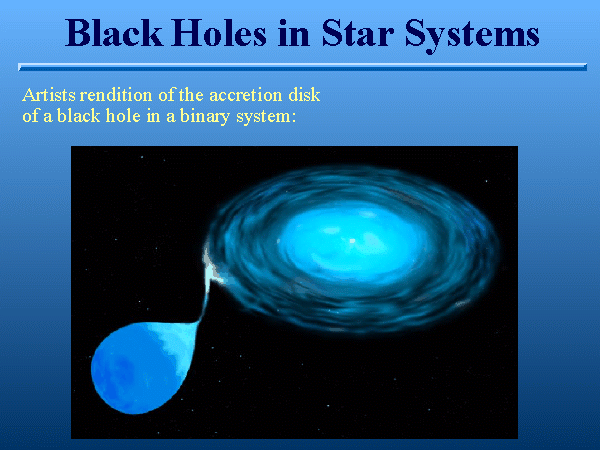
5 Black Holes in Star Systems

Luckily, black holes are rarely
formed in complete isolation. There is almost always other matter
around. For example, binary star systems, which contain two stars in
close orbit, are very common. This slide is an artist's rendition of
what it would look like of one of the stars in a binary system
collapsed into a black hole The intense gravitational field of the
black hole sucks matter off of the companion star. The matter does not
fall directly into the black hole. It swirls around and spirals in,
much like water down a bathtub drain. As this matter fell towards the
black hole it gains energy, and heats up to the point where it emits a
great deal of radiation (x-rays in fact). This radiation is emitted
while the matter is still relatively far from the black hole, so it can
escape and this is what we detect. The evidence is somewhat
circumstantial, since the same sorts of x-rays would be emitted even if
the collapsed star was some other compact object such as a neutron star
or white dwarf. However, if we can measure the masses of the two stars,
and the collapsed star is heavy enough, theoretical arguments force us
conclude that the x-rays are being emitted by matter falling in to a
black hole.
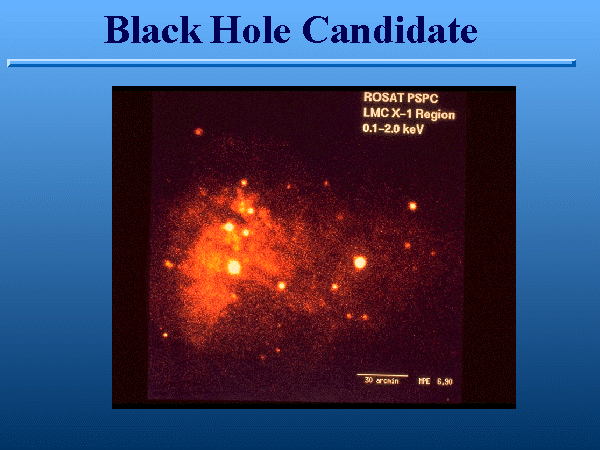
5.1 Black Hole Candidate

This slide shows the x-rays (in red)
being emitted by a black hole candidate. We can see the bright
companion star in the center, but the black hole does not emit visible
light, only x-rays.
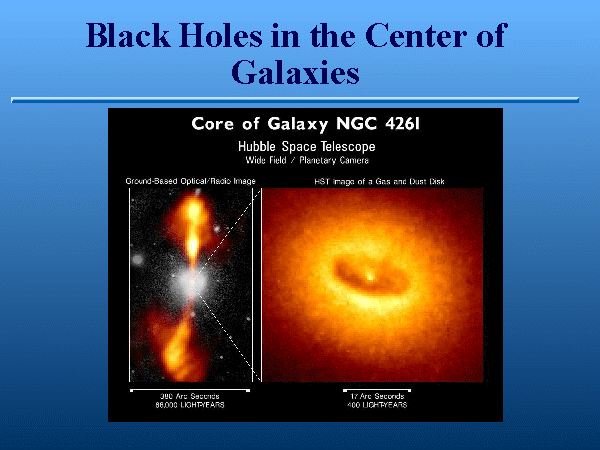
5.2 BH in the Center of Galaxies

This is the slide I started with. It
is a spectacular picture taken by the Hubble space telescope of the
matter (stars) swirling around a smaller black hole (only 500 million
suns) in a distant galaxy. Note that it looks very much like the
artist's rendition I showed you earlier. The two jets of matter that
you see on the left are basically thrown out by the intense swirling
motion near the center.
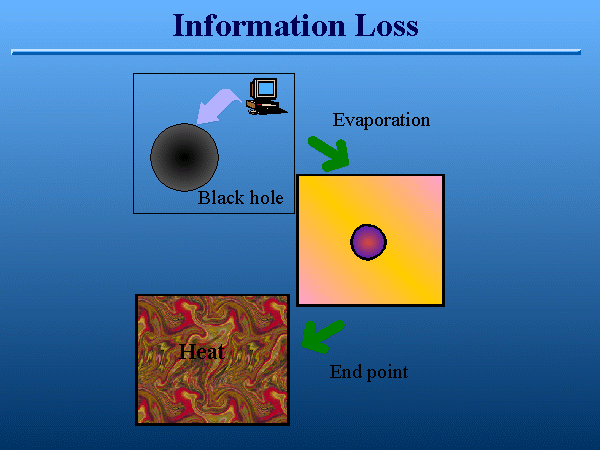
6 Why are Black Holes Important?
Hopefully I have indicated what black holes are, some of their properties and why we believe they exist. Why are they important, apart from providing material for Star Trek episodes, and in particular, why I am spending a great deal of time studying them theoretically? Stephen Hawking showed in the mid-seventies that black holes aren't black. They glow in the dark like very faint light bulbs. They emit radiation via microscopic processes that occur just outside the horizon. The net effect is to remove energy from the black hole, although at a very, very slow rate. Thus black holes ultimately evaporate. In reality, a solar mass black hole will take many many times the lifetime of the Universe to evaporate, so who cares? This process gives rise to two related fundamental theoretical problem: the problem of information loss and the mysterious source of black hole entropy. The first is a bit easier to visualize, so I will describe that.6.1 Information Loss

Suppose I throw a computer into a
black hole. This computer's hard disc contains a great deal of usefull
(and useless) information. Once the computer falls below the "point of
no return", the information on this hard disc is lost for ever to the
outside world. This is not a problem since in principle, if I wanted it
badly enough, I can fall down the black hole after it, and retrieve it.
But now we know that black holes are not stable: they evaporate.
Moreover, this evaporation occurs due to microscopic processes just
outside the "horizon", and it cannot know about anything what has
already fallen through the horizon. Thus it cannot contain any
information about what is inside: the radiation that it emits carries
no information. We call it pure heat, or thermal radiation. The second
picture indicates the black hole after it has evaporated a little: the
surrounding universe is a bit hotter, and the black hole, which has
lost energy, is correspondingly smaller. If we follow this process to
its logical conclusion, what we have at the end is no black hole, only
thermal radiation filling the universe. The information on the hard
disc has irrevocably disappeared along with the black hole, and there
is no way to retrieve it, even in principle. In physics, such
information loss is unacceptable: it means among other things that the
future cannot be predicted by knowing the past. There is no apparent
correlation between the thermal radiation that fills the Universe, and
the state of the Universe (i.e. the hard disc) before it was thrown
into the black hole.